Old Meets New: Legacy system modernization with a .NET Makeover
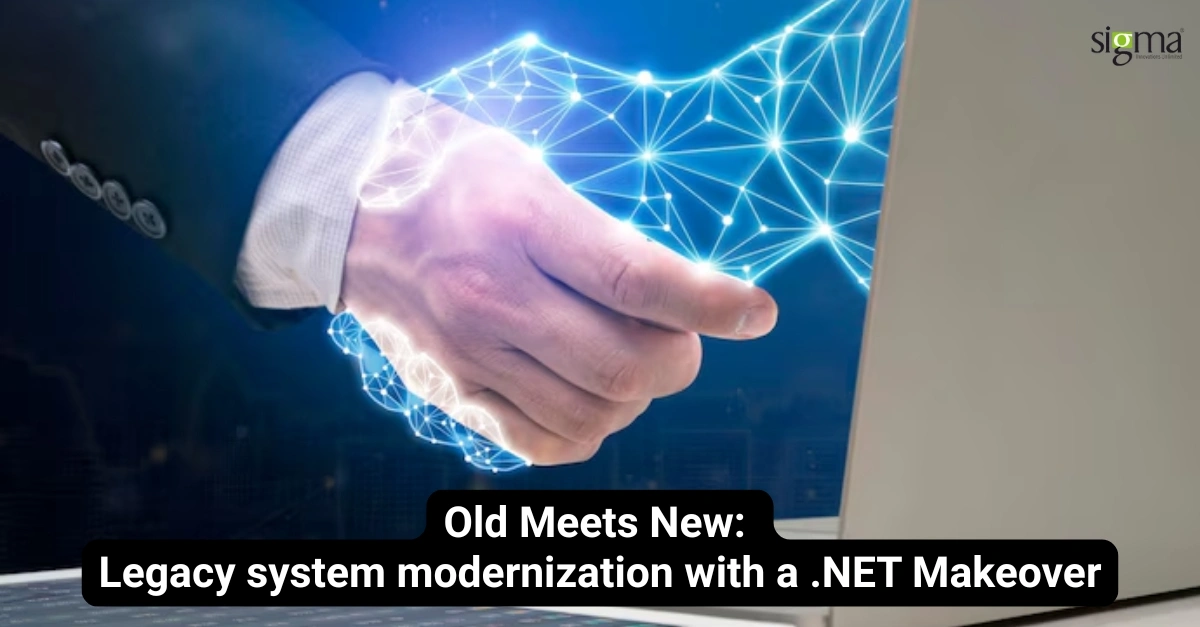
Let’s face it—technology moves fast. What felt cutting-edge just a few years ago might now be slowing your business down. That’s especially true for legacy systems, which are the older software applications and infrastructure many companies still use to run core operations. Think of them like a flip phone in the age of smartphones—functional, yes, but far from efficient.
Staying competitive means being fast, secure, and flexible in the eCommerce and FinTech world. However, legacy systems often lack the performance, security, and scalability that modern businesses require. They can’t keep up with today’s customer expectations or the speed of innovation. Plus, maintaining outdated codebases is like patching an old boat—you fix one leak, and two more pop up.
This is where legacy system modernization comes into play. And we’re not just talking about surface-level upgrades. We’re talking about a full-blown .NET makeover that helps businesses tap into modern capabilities without throwing everything out and starting from scratch.
In this blog, we’ll explore how businesses can merge their existing legacy infrastructure with the power of modern .NET development services. We’ll walk through how this transformation boosts performance, tightens security, and scales easily with growth. You’ll also discover how integrating cloud native technologies and adopting smart DevOps practices can help streamline the transition.
So, if your current tech stack feels more like a burden than a business enabler, keep reading. It’s time to rethink, retool, and rejuvenate—with .NET leading the charge.
What Are Legacy Systems—and Why Do They Still Exist?
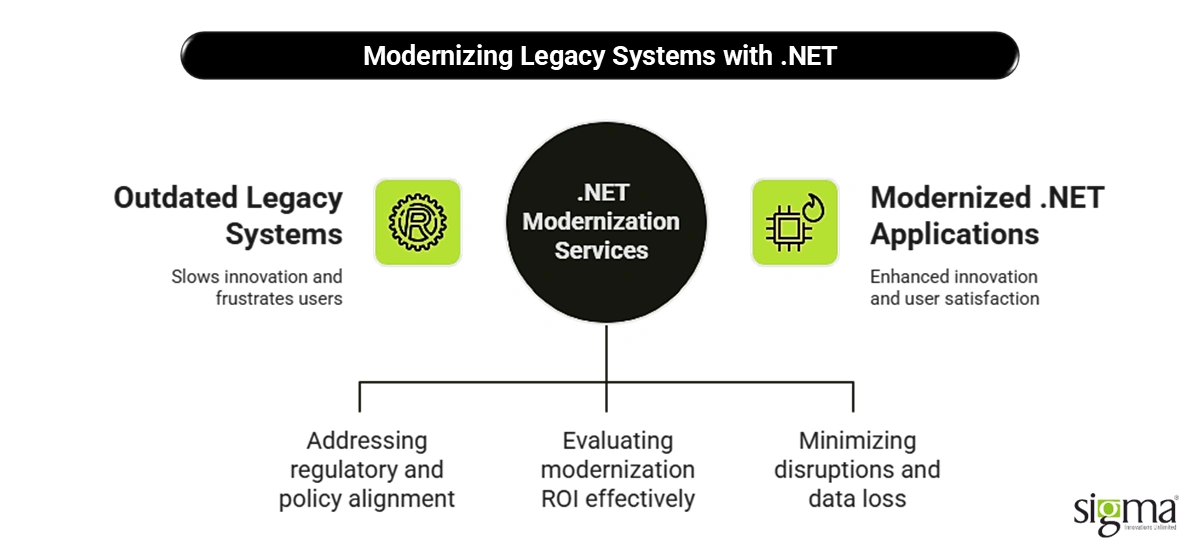
Legacy systems are like that old, reliable truck you’ve had for years—still runs, still hauls, but way behind on fuel efficiency, safety features, and speed. In technical terms, legacy systems refer to outdated software platforms, programming languages, or infrastructure that are still in use despite being outdated and no longer in their prime. These systems often rely on aging technologies like COBOL, VB6, Classic ASP, or even early versions of the .NET Framework (4.5 or earlier).
They’re typically custom-built and deeply integrated into business operations, which is why they’re hard to walk away from. You’ll often find them running mission-critical functions in industries like FinTech and eCommerce, where changing anything too quickly can risk compliance issues or break essential workflows.
Now, here’s the surprising part—over 70% of enterprise systems still run legacy applications, according to Gartner. Why? The answer comes down to three big reasons: compliance, cost, and complexity.
- Compliance: In highly regulated sectors like FinTech, legacy platforms are often tightly aligned with long-standing policies and processes. Changing them means navigating a minefield of audits, certifications, and legal approvals.
- Sunk Cost: These systems represent years—even decades—of investment. Many businesses hesitate to modernize because they fear losing their return on that original investment.
- Operational Risk: It’s not easy to lift and shift a core banking platform or a transaction processing engine overnight. Teams worry about disruptions, data loss, or learning curves that might impact service quality.
Still, sticking with outdated tech is like driving with the emergency brake on—it slows innovation, frustrates users, and limits growth. That’s why more organizations are turning to legacy system modernization through .NET modernization services, allowing them to keep what works while updating what doesn’t.
Why .NET is the Ideal Framework for Modernization
When it comes to legacy system modernization, few platforms offer the flexibility, performance, and long-term reliability that .NET does. It’s not just a tech upgrade—it’s a strategic move toward scalability, security, and cross-platform innovation. So why is .NET the go-to choice for businesses looking to revamp their outdated systems?
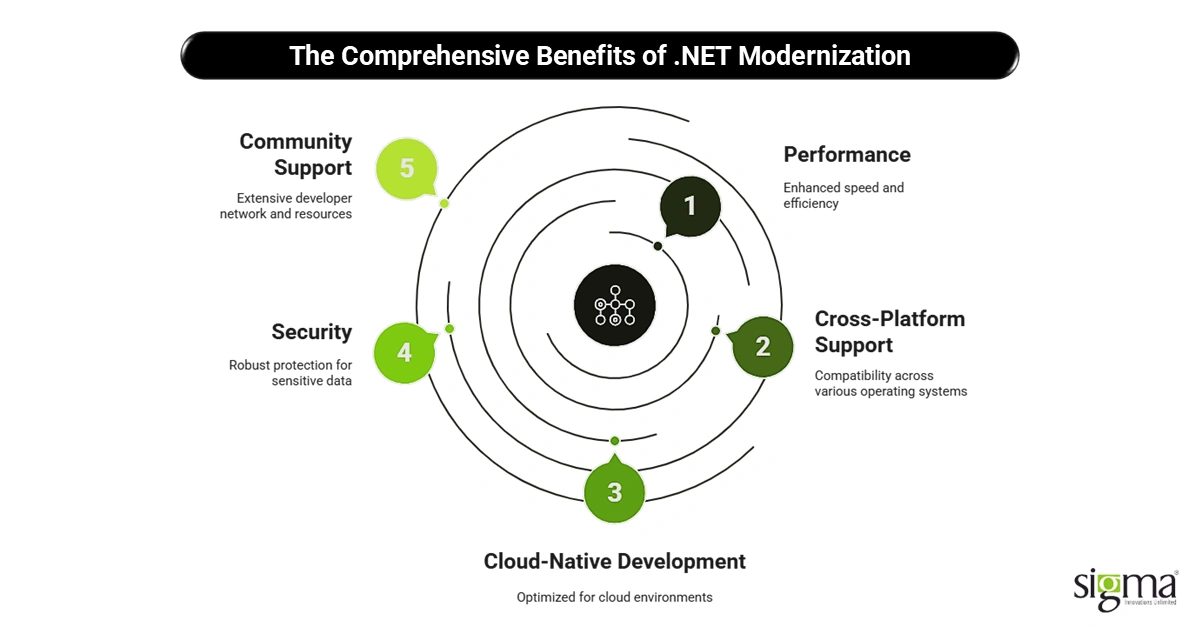
Let’s rewind a bit. The .NET ecosystem has come a long way since its early days. What started as the Windows-only .NET Framework has evolved into a modern, lightweight, and blazing-fast solution: .NET Core, and now the unified platform—.NET 6, 7, and 8. With each version, Microsoft has sharpened its focus on speed, cloud-readiness, and developer productivity.
A recent benchmark showed that .NET 8 is projected to be 24% faster than .NET 7, making it one of the highest-performing development frameworks available today. That’s a big deal for applications handling high-volume transactions in sectors like FinTech and eCommerce, where every millisecond counts.
Cross-platform support is another game-changer. Whether your business runs on Windows, Linux, or macOS, modern .NET lets you build once and run anywhere—reducing operational silos and streamlining development. Combine this with cloud-native development with .NET, and you’ve got the perfect environment for containerization, microservices with .NET Core, and rapid scaling.
Security? It’s baked in. Microsoft continuously rolls out security patches and compliance-ready tools, which is a must for businesses managing sensitive financial or customer data. This makes .NET an obvious fit for regulated industries where data integrity and risk mitigation are non-negotiable.
On top of all this, the .NET ecosystem is backed by a massive developer community and Microsoft’s enterprise-grade support. That means no shortage of skilled talent, best practices, tools, and ready-to-go libraries. Whether you’re rewriting legacy systems in .NET Core or just exploring the benefits of modernizing with .NET, you’re never alone on the journey.
At its core, .NET enables faster builds, smoother integrations, and future-ready applications. For companies looking to transform old systems without blowing up their entire IT stack, .NET-based digital transformation is more than an option—it’s a smart move.
Also Read: AI, Low-Code, & DevOps: The Triad of Software Product Engineering Services
Common Modernization Approaches
Modernizing a legacy system isn’t a one-size-fits-all journey. Depending on your business goals, existing tech stack, and budget, there are several ways to move forward—each with its own pros and cons. In the world of legacy system modernization, the industry often refers to the 6 R’s of Application Modernization: Rehost, Replatform, Refactor, Rearchitect, Rebuild, and Replace.
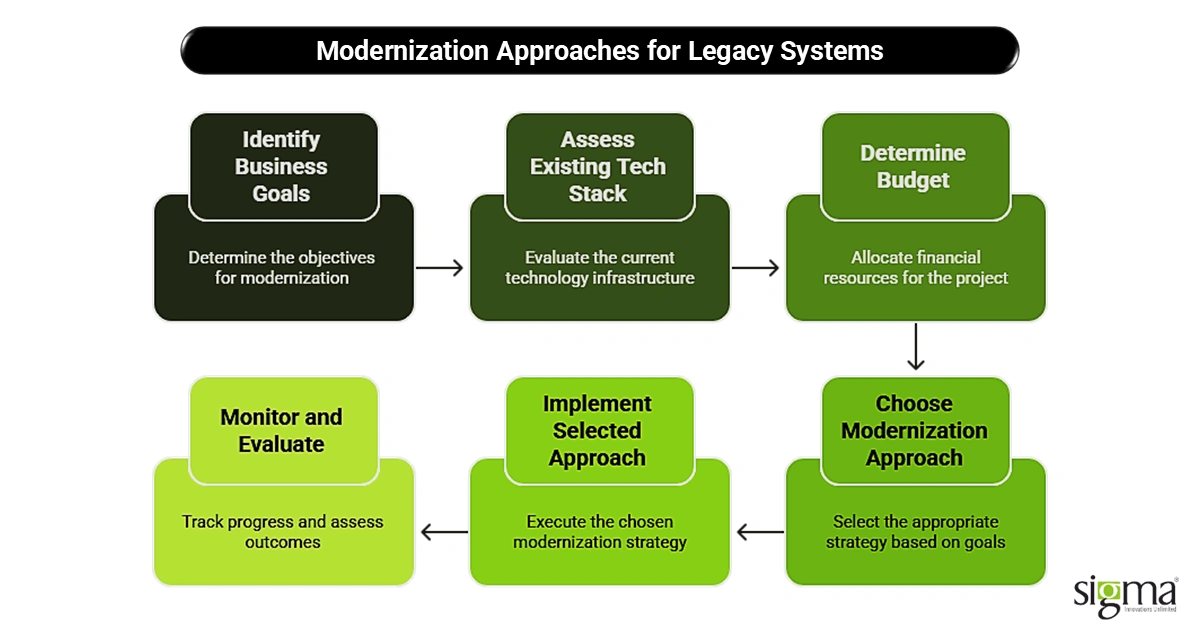
Let’s break these down—and explore which paths make the most sense for .NET-based applications.
Rehost (Lift & Shift)
This is the simplest route: you move your application from on-premises servers to the cloud without changing much. It’s quick, relatively low-cost, and gets you some of the benefits of cloud native technologies without diving deep into code.
Best for: Businesses needing quick cloud migration with minimal disruption.
Replatform
Here, you move to a different platform while making small adjustments—like shifting from traditional IIS hosting to containerized deployment with Docker or Kubernetes. For .NET applications, this often involves minor changes to support DevOps practices and cloud deployment.
Best for: Teams ready for operational improvements without rewriting the entire app.
Refactor
This means reworking parts of your codebase to make it more efficient or cloud-ready. You’re not rebuilding the app—just reshaping it to run better. For example, you might break a monolithic .NET Framework app into microservices with .NET Core or enable APIs to improve integration.
Best for: Businesses looking to modernize gradually while maintaining stability.
Rearchitect
This approach involves a deeper transformation—changing the app’s architecture entirely. Think: going from a monolithic structure to a fully distributed, event-driven system. It often involves embracing .NET-based digital transformation with services like Azure Functions or Kubernetes.
Best for: Large enterprises aiming for high scalability and agility.
Rebuild
Sometimes the best option is to start fresh. Rebuilding means rewriting your application from scratch using modern dot net development services. It’s a bigger investment, but it pays off with long-term flexibility, performance, and future-proofing.
Best for: Legacy systems that are too brittle or inefficient to salvage.
Replace
If your existing app no longer meets your needs—or isn’t worth modernizing—you can replace it entirely with a new solution. This might involve adopting a ready-made SaaS product or custom-building a modern app with cloud-native development with .NET.
Best for: Outdated systems with poor ROI or limited business value.
Pro Tip – Refactor vs. Rebuild for eCommerce Platforms
If your eCommerce platform is stable but struggling with performance or integrations, refactoring with .NET Core and API enablement for legacy systems may be your best bet. But if your site is slow, clunky, and hard to maintain, rebuilding on a modern .NET foundation can unlock better UX, scalability, and time-to-market.
Signs You Need to Modernize Your Legacy .NET System
Still wondering if it’s time to give your aging system a .NET makeover? You’re not alone. Many eCommerce and FinTech businesses wrestle with whether to hold on or move forward.
The truth is, while legacy apps may still “work,” they often come with hidden costs—slower performance, higher maintenance, security risks, and limited room for growth. And if you’re on .NET Framework 4.5 or earlier, you’re likely bumping into walls that modern systems have long outgrown.
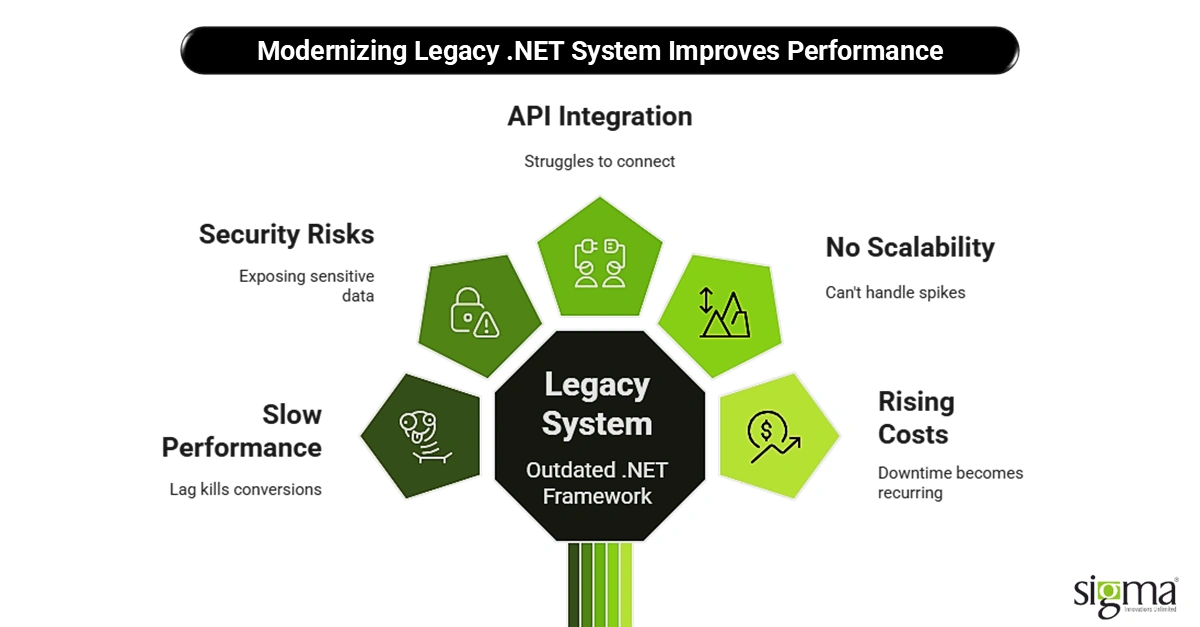
Here are some clear warning signs that your business is overdue for legacy system modernization:
Slow Load Times & Poor Performance
Your system takes forever to load, run processes, or handle increased traffic. Modern users expect speed—lag kills conversions.
Security Vulnerabilities
Unsupported versions of .NET are magnets for cyberattacks. Without ongoing patches or updates, you risk exposing sensitive data.
API Integration Is a Nightmare
Today’s digital platforms run on APIs. If your legacy system struggles to connect with payment gateways, CRMs, or cloud tools, you’re missing out on vital business functionality.
Scalability Is Nonexistent
If your platform can’t handle spikes in user activity—or scaling requires tons of manual intervention—it’s time to rethink things with cloud-native development with .NET.
Rising Maintenance Costs
Patching outdated systems is like playing Whac-A-Mole. Costs keep going up, and downtime becomes a recurring problem.
Scarcity of Developers for Old Tech
Try finding a developer who still codes in VB6 or legacy ASP. It’s not just difficult—it’s expensive. Talent is moving toward modern frameworks like .NET Core, leaving older tech in the dust.
You’re Falling Behind Competitors
If your competition is rolling out new features quickly while you’re stuck in testing cycles or tech debt, you’re at a disadvantage.
By identifying these red flags early, you can avoid costly surprises and proactively plan for a smarter, smoother transition using .NET modernization services.
Also Read: From Legacy to Leading Edge: The InsurTech Revolution That’s Reshaping Insurance
.NET Modernization in Action: Real-World Use Cases
Still on the fence about whether .NET modernization services are worth the effort? Let’s break it down with two real-world scenarios where legacy systems got a new lease of life through modern .NET technologies.
GovTech: Transforming Massachusetts Lemon Law with .NET Digital Workflows
The Massachusetts Attorney General’s office was managing Lemon Law arbitration requests using a legacy, paper-based system. It caused massive inefficiencies, long turnaround times, and lacked transparency for consumers and administrators alike.
Sigma Infosolutions stepped in to modernize the entire process using a .NET-powered digital workflow solution. The team built a secure, centralized web application that digitized form submissions, automated eligibility checks, and streamlined communication between all parties involved.
Results:
- 10x productivity boost
- Reliance on physical storage was cut by 95%
- Real-time case tracking for consumers and internal teams
This transformation not only improved citizen experience but also set a new benchmark for public-sector digital innovation.
Read Full Case Study: Transforming Massachusetts’ Lemon Law Process – From Paper to Digital Excellence
FinTech: Automating Customer Success for a Lending-as-a-Service Platform
A leading Lending-as-a-Service (LaaS) platform was facing operational bottlenecks with its customer success process. Manual case handling, limited reporting, and a rigid legacy system were slowing down growth and impacting client satisfaction.
Sigma helped by engineering an intelligent, automated customer success engine using modern .NET microservices and workflow automation. The new solution enabled faster onboarding, automated reporting, and real-time analytics dashboards.
Results:
- 50% reduction in team size, thanks to automated workflows.
- 100% visibility into client engagement metrics
- Scalable architecture ready for rapid customer growth
This case exemplifies how .NET modernization can be a strategic lever for FinTechs aiming for scalable growth and superior client experience.
Read Full Case Study: Streamlining Customer Success for a Lending-as-a-Service Platform with Automation
Key Tools and Technologies Powering .NET Makeovers
Modernizing a legacy system isn’t just about rewriting code—it’s about using the right tools to build faster, smarter, and more scalable applications. When it comes to legacy system modernization with .NET, a modern tech stack can make all the difference in how smooth, secure, and future-ready your transformation is.
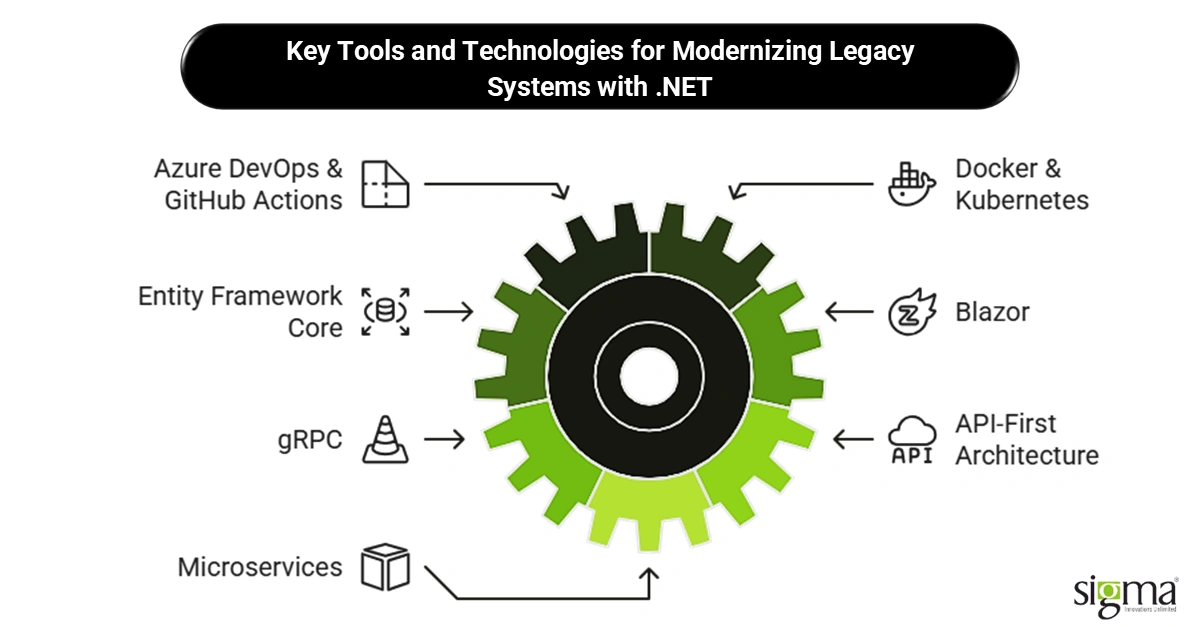
Here’s a look at the key tools and technologies that are driving .NET-based digital transformation across industries like eCommerce and FinTech:
Azure DevOps & GitHub Actions
These tools help automate build, test, and deployment pipelines—aka, the lifeblood of DevOps practices. With continuous integration and delivery (CI/CD), your development team can release features faster, catch bugs earlier, and improve collaboration across teams.
Docker & Kubernetes
Containerization with Docker lets you package applications with all their dependencies, so they run the same everywhere—from a developer’s laptop to a production cloud server. Add Kubernetes, and now you’re orchestrating and scaling your cloud-native development with .NET like a pro.
Entity Framework Core
This modern ORM (Object-Relational Mapper) simplifies working with databases in .NET apps. It’s efficient, lightweight, and perfect for both legacy migrations and microservices.
Blazor
Want to build rich, interactive web UIs using just C#? Blazor makes that possible, giving .NET developers the ability to ditch JavaScript-heavy frameworks while still delivering slick, responsive front ends.
gRPC
For high-performance communication between services, gRPC offers a faster, more efficient alternative to traditional REST APIs—ideal when you’re building microservices with .NET Core.
API-First Architecture
Modern .NET apps are built with API enablement for legacy systems in mind. By starting with APIs, you ensure easy integration with other tools, services, and platforms—future-proofing your ecosystem.
Microservices
Breaking down large legacy systems into modular microservices allows you to scale specific parts of your app independently. It also helps teams work in parallel, speeding up delivery and reducing downtime.
With the right tools in your corner, dot net development services can transform your slow, aging platform into a secure, agile powerhouse.
Security, Compliance & Scalability: Hidden Benefits of .NET Modernization
When businesses talk about legacy system modernization, most focus on the obvious perks—faster performance, better UI, and smoother integrations. But there’s more to a .NET makeover than meets the eye. Behind the scenes, it quietly strengthens three critical areas: security, compliance, and scalability.
Let’s start with security. Modern .NET applications come with built-in identity and access management features through frameworks like ASP.NET Core Identity and seamless integration with tools like Azure Active Directory. That means multi-factor authentication, role-based access control, and protection against common threats (SQL injection, XSS, CSRF) are easier to implement—and keep updated.
On the compliance front, .NET makes life easier for companies operating in highly regulated industries like FinTech and eCommerce. Microsoft’s .NET and Azure platforms support out-of-the-box integrations with major standards like SOC2, PCI DSS, and HIPAA. So whether you’re handling payments or personal health data, you’re better equipped to meet industry requirements without reinventing the wheel.
Then there’s scalability. Thanks to cloud-native technologies, containerization with Docker, orchestration with Kubernetes, and native support for horizontal scaling on Azure or AWS, .NET apps can grow with your business—without causing growing pains. Whether you’re serving 100 users or 1 million, you stay fast and responsive.
So while modernization might start as a business decision, it delivers massive technical wins behind the curtain. That’s why more companies are choosing .NET modernization services—not just to upgrade, but to fortify.
Modernization Pitfalls to Avoid
Modernizing your legacy .NET system can unlock serious value—but only if you avoid the common traps that can turn a good plan into a costly misstep. At Sigma, we’ve seen firsthand how even well-funded modernization efforts can go sideways when the wrong assumptions are made.
Here are three critical pitfalls to steer clear of:
1. Leaving Out Business Users
Developers and IT teams may be leading the charge, but it’s your business users who live and breathe the application every day. Failing to include them in planning means you risk building a solution that doesn’t actually solve the right problems—or worse, introduces new ones. Involving stakeholders early helps ensure the modernized system meets real-world needs.
2. Underestimating Data Migration
Moving from legacy databases to a new .NET-based digital transformation platform sounds simple… until you hit the data. Legacy systems often have decades of tangled, inconsistent, or unstructured data. Not planning for schema mapping, validation, and rollback mechanisms can turn migration into a nightmare.
3. Rewriting Everything at Once
It’s tempting to “rip and replace,” but rewriting your entire app from scratch is risky, expensive, and time-consuming. Instead, take an incremental approach—modernize in stages using DevOps practices, API enablement, and microservices with .NET Core to reduce downtime and keep things agile.
What Not to Do: A Quick Alert
- Don’t treat modernization as an IT-only project.
- Don’t underestimate the complexity of data.
- Don’t go all-in on rewriting unless necessary.
Step-by-Step .NET Modernization Roadmap
Ready to give your old system a new lease on life? Before diving into a legacy system modernization project, it’s essential to have a solid plan in place. Whether you’re in FinTech or eCommerce, a structured approach reduces risk, saves time, and ensures your modernized app delivers real business value.
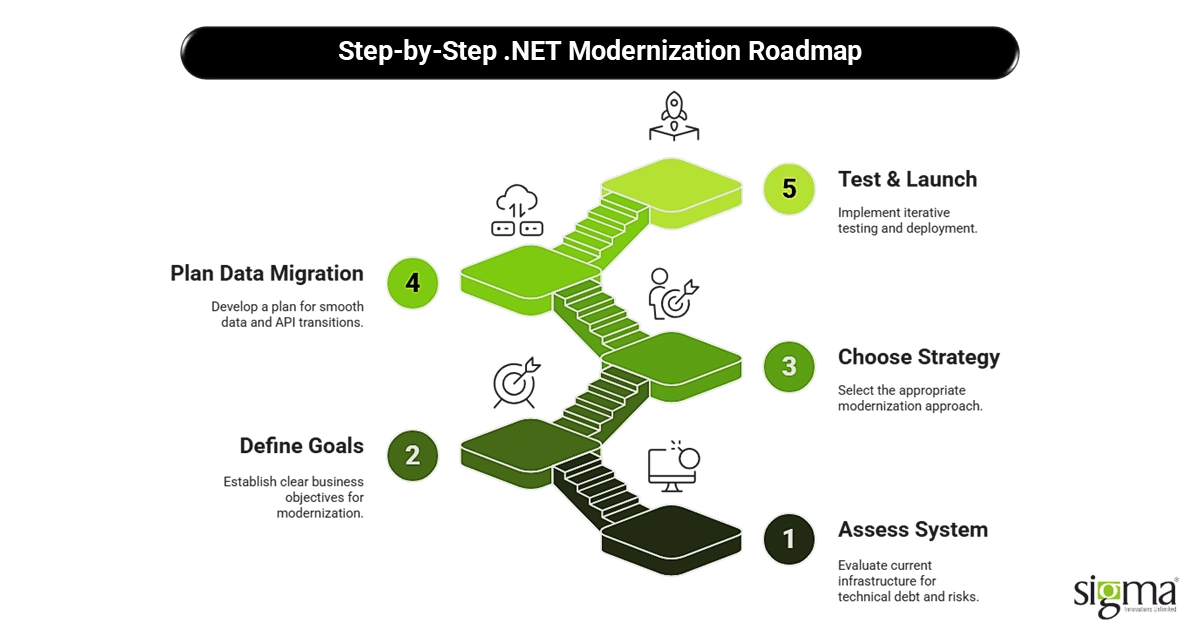
Here’s a step-by-step roadmap for modernizing your legacy application with the power of modern .NET technologies:
1. Assess Your Current System
Start with a thorough audit of your existing infrastructure. Where is your technical debt piling up? Are there performance bottlenecks, security risks, or unsupported dependencies (like old .NET Framework versions)? This is where tools like static code analyzers, performance profilers, and security scanners can help. Identify what works, what doesn’t, and what must change.
2. Define Business Goals
Modernization isn’t just a tech decision—it’s a business one. Are you trying to improve time-to-market? Reduce operational costs? Increase system availability? Clear goals help shape the right approach, whether it’s refactoring for speed or replatforming for cloud-readiness.
3. Choose the Right Modernization Strategy
Using the 6 R’s of Application Modernization (Rehost, Replatform, Refactor, Rearchitect, Rebuild, Replace), choose the strategy that aligns with your system’s needs and your business priorities. For many .NET-based systems, starting with refactoring or replatforming offers the best return with minimal risk.
4. Plan for Data Migration & API Transition
Legacy data can be messy, and moving it cleanly is half the battle. Map your data models, define validation rules, and plan for migration rollbacks. At the same time, begin enabling key parts of your system with APIs to allow smoother integration. Think API-first architecture and cloud-native development with .NET.
5. Test & Launch Iteratively
Avoid the “big bang” launch. Use DevOps practices to build CI/CD pipelines and deploy in smaller, manageable phases. This way, you can test thoroughly, gather feedback, and course-correct as needed. By launching iteratively, you reduce downtime and create space for continuous improvement.
By following this roadmap, your business can confidently move from legacy to legendary—using modern dot net development services and tools that scale with you. Whether it’s better performance, tighter security, or improved agility, the results are well worth the effort.
Embrace the Future, Respect the Past
Modernizing legacy systems isn’t about throwing away what you’ve built—it’s about making it better, faster, and future-ready. Your legacy .NET apps were the backbone of your business for years. Now, it’s time to evolve them with modern tools and thinking.
The good news? .NET is built for this moment. With its performance boost, cross-platform flexibility, cloud-native capabilities, and strong community support, it offers the perfect path forward. Whether you’re aiming for faster releases, better integrations, or long-term cost savings, .NET modernization services deliver results you can measure and scale.
But modernization isn’t just a technical upgrade—it’s a strategic decision. It’s about creating a foundation that lets your business respond faster, innovate more easily, and grow stronger in the digital age. When you combine smart technology with clear business goals, the result is true transformation.
That’s why a successful modernization journey needs a trusted partner who gets both the tech and the strategy.
At Sigma Infosolutions, we specialize in helping businesses modernize legacy systems with precision, speed, and impact. With deep expertise in .NET development, cloud-native architectures, and DevOps, we partner with FinTech and eCommerce leaders to unlock agility, enhance scalability, and deliver measurable value.
Ready to modernize with confidence?
Let’s talk. Explore our end-to-end Development Services and see how we can help transform your legacy into leadership!
